Undergraduate Research
Students have produced an extraordinary variety of quality work in various independent research projects. Like any engineering project, much of the work lies in the documentation, and I require cadets to provide an oral presentation and submit a written project report and a web page for every project undertaken. The following pages show a sampling of the research work of some of the students I have advised. These are truly some of the finest men and women with whom I have had the pleasure of collaboration.
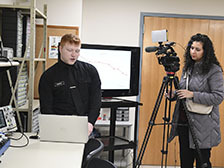 |
AudiologyCole Bowyer '25, Binh Tranh '23, William Flathers '07We created a simulation to allow parents of hearing-impaired children to hear the world that their children hear. They can input their child's audiology report into the simulator, and then either speak into the microphone or select various pre-recorded sound snippets, and hear how their children would perceive those sounds. It was featured on WDBJ7 News on 22 Jan 2024. link |
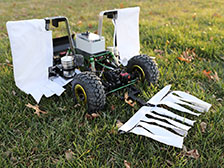 |
Tick Rover Gen IVFrancis Celantano '20, Michael St.John '20, Eric Munro '21, Joseph Lieber '23We constructed a robot for CDT Celantano's thesis for biomedical research to be carried out by Dr. Holly Gaff at Old Dominion University. We entered the robot in the IEEE CASS competition, where we were selected to represent Region 3 in the US national-level competition. link |
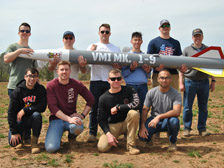 |
Mars Rover ChallengeClay Penney, David Hair, Gerald Hempt, George Hempt, Brian Hill, Oscar Lloyds, Kishan Patel, Drake Singh, Johnathan Tran, '19We entered an inter-university contest in which we built a large (11' tall) rocket that launched an autonomous robot over 1,000'. The robot deploys a parachute, lands, detaches from the parachute, and then navigates a path while collecting soil samples and sending photos of the sample sites by wireless telemetry to a base location. It earned third place out of eleven competitors and was covered by WDBJ and the Roanoke Times. link |
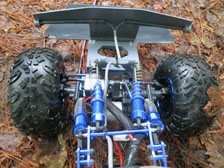 |
Tick Rover Gen IIINathan Howard, Stuart Hughes, and John Ruhl, '13We are building the third generation of the Tick Rover with the generous aid of the VMI Foundation. The model has been improved from Generation II in many ways including improved velocity sensing, higher torque motors, response to being flipped over, anti-fouling axials, and computer-regulation of the base station. The student team won second place in the URS undergraduate research conference for engineering. After testing in in early June by the Old Dominion University team of Drs. Dan Sonenshine and Holly Gaff it was featured in a number of newspaper articles and television reports (click here and expand the Popular Media/Television section). |
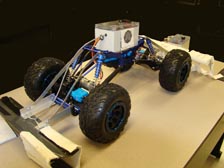 |
Tick Rover Gen IITommy Kendzia and Ben Absher, '12In 2012 Tommy Kendzia and Washington and Lee student Ben Absher constructed an improved version of the first generation tick rover originally tested in 2006. This second generation robot was designed to be rugged enough to withstand independent laboratory testing for two weeks at Fordham University. The robot was demonstrated at the Virginia Academy of Science and the MARCUS undergraduate research conference at Sweet Briar. link |
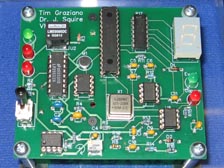 |
Sniper Fire IdentificationTimothy Graziano, '09This device identifies the sonic signature of a gunshot using digital signal processing, and measures the audible strength of the sound on an LED. The intent was to synthesize a network of three of these to provide a wearable device that could immediately triangule the position of sniper fire in an urban battlefield situation. Tim earned second place in the VMI Undergraduate Reseach Symposium in engineering for the device, and presented at BigSURS 2010 at Radford College. link |
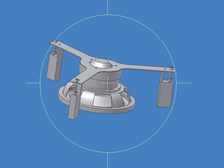 |
Seismic CommunicationWill Flathers, '07The Seismic Communicator uses seismic waves to allow miners trapped in an underground mine collapse to inform rescue teams of their positions and vital statistics. Tested to more than 200' in the Natural Bridge Caverns, this project was a feature segment on Discovery Channel Canada, won first place in the IEEE sectional paper competition, and is patented and licensed. link |
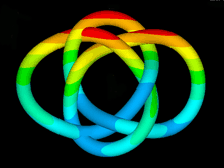 |
Endovascular StentsRaevon Pulliam and Lisa Martinez '07Washington & Lee premed student Lisa Martinez teamed with VMI mechanical engineers Raevon Pulliam and Ted Davis to investigate a novel endovascular stent weave pattern inspired by ancient Celtic knots. Their work was featured on local TV WSLS and published/presented at the 2008 National Council of Undergraduate Research. link |
 |
Hearing Impairment SimulatorG. Will Flathers '07The Hearing Impairment Simulator allows parents of hearing-disabled children to hear as their children hear. Parents enter their child's audiology chart and record their own voice or a pre-recorded sound for processing. The project is co-advised by Roger Ruth, M.D., president of the American Academy of Audiology, won second place among engineering posters at the VMI URS 2006 and was featured on Channel 10 News, Roanoke, WSLS. link |
 |
Tick-Collecting RobotJustin Woulfe, Barry Hammond, and Dennis Crump '05The Autonomous Tick Rover collects and exterminates ticks while traversing an area. The robot follows a chemoattractant tube that attracts ticks to the robot's path. It won first place in the VMS Section's 2005 IEEE student paper's contest and a Wetmore Research Grant. Patent rights were filed in 2006 naming the cadets and their advisors as the primary inventors. link |
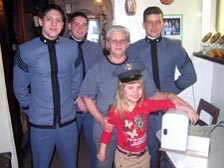 |
Internet-Aware Medical RefrigeratorMatthew York '04, Paul Kuwick '05, Tom Largi '05, and Dennis Crump '06The Internet-Aware Medical Refrigerator monitors how frequently a patient takes a medication (e.g. insulin, as shown during field testing by a diabetic patient). If an unexplained delay is detected it sends a warning email to the patient's family and doctor. It won first place in engineering in the 2004 VMI Undergraduate Research Symposium. link |
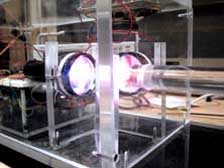 |
Museum of Science Optical Multiplexer DemoPaul Kuwik and Tom Largi '05Kuwik and Largi designed this demonstration to show how multiple different signals can be combined onto a single communications line, such as on a computer network or telephone wire. Combining optics, microprocessors, and analog control circuitry it was displayed in the 2003 VMI URS Symposium and earned a Wetmore Research Grant. link |
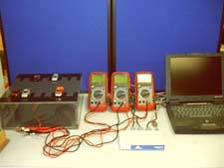 |
Museum of Science Optical Multiplexer DemoPaul Kuwik and Tom Largi '05The Computerized Parking Garage routes cars in a crowded garage to an optimal parking space. The system combines electrical and computer engineering and mathematics in an algorithm and internet-based hardware to provide a solution to this difficult problem. Students have a patent on the technology and are seeking licensure. It won first place in engineering in the 2003 VMI Undergraduate Research Symposium. link |
 |
Smart CatheterMatt Brooks and Steve Lee '02The Smart Catheter Project involved constructing biomedical catheters with integrated sensors and the hardware and software necessary to display the results on a laptop computer. The work was funded by a grant from MIT and resulted in first place sectional and regional 2002 IEEE Student Paper Competition awards (one of seven such awards in the country), a Hinman Research Award, and an honors thesis for Brooks. link |
 |
Museum of Science Laser Communication DisplayMatt Brooks '02 and Brian Holt '05Brooks, Holt, and the ECE class of 2001 designed this demonstration of laser-based communication systems for the Science Museum of Western Virginia. It won third place in the 2002 VMI Undergraduate Research Symposium. link |